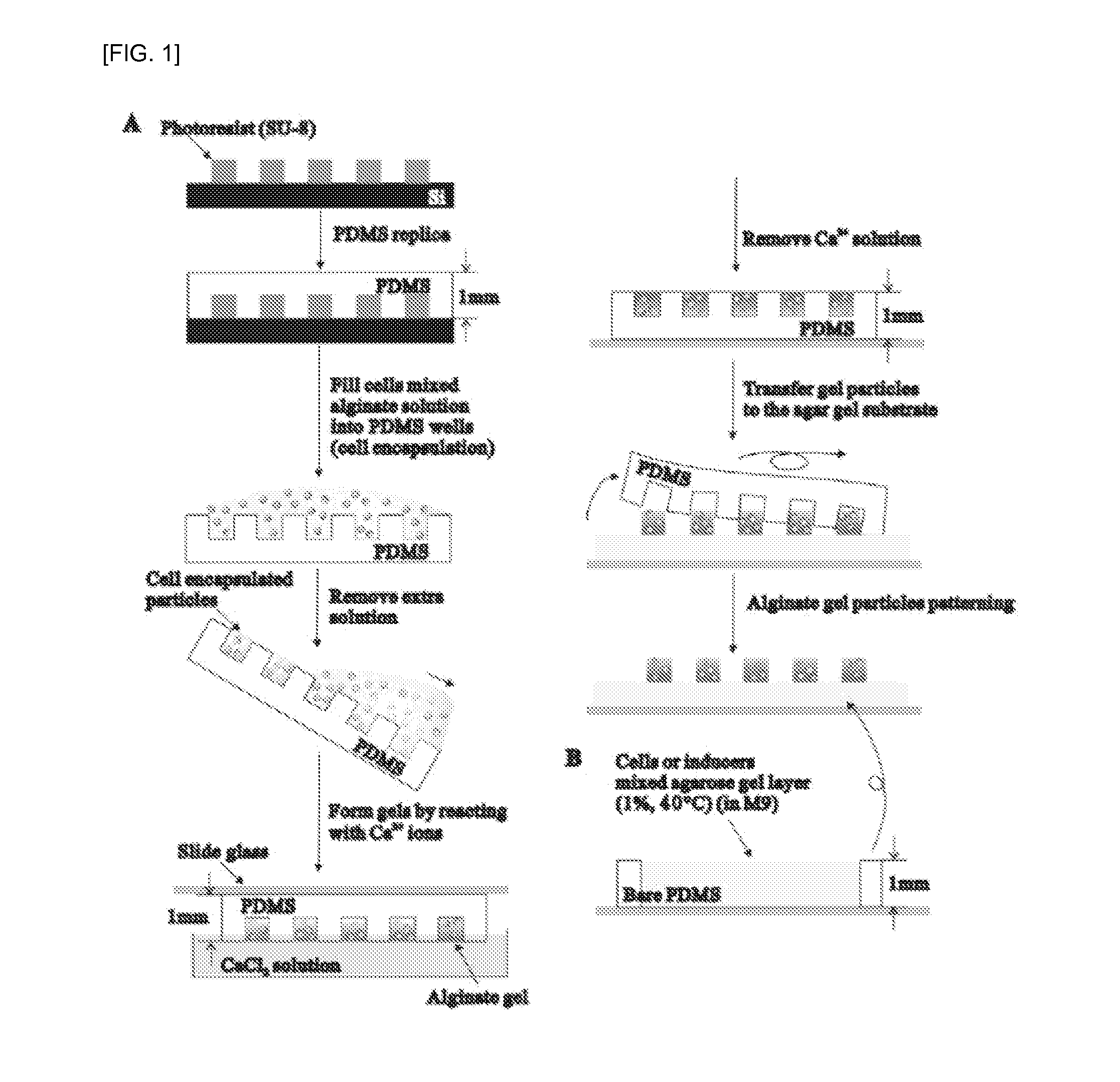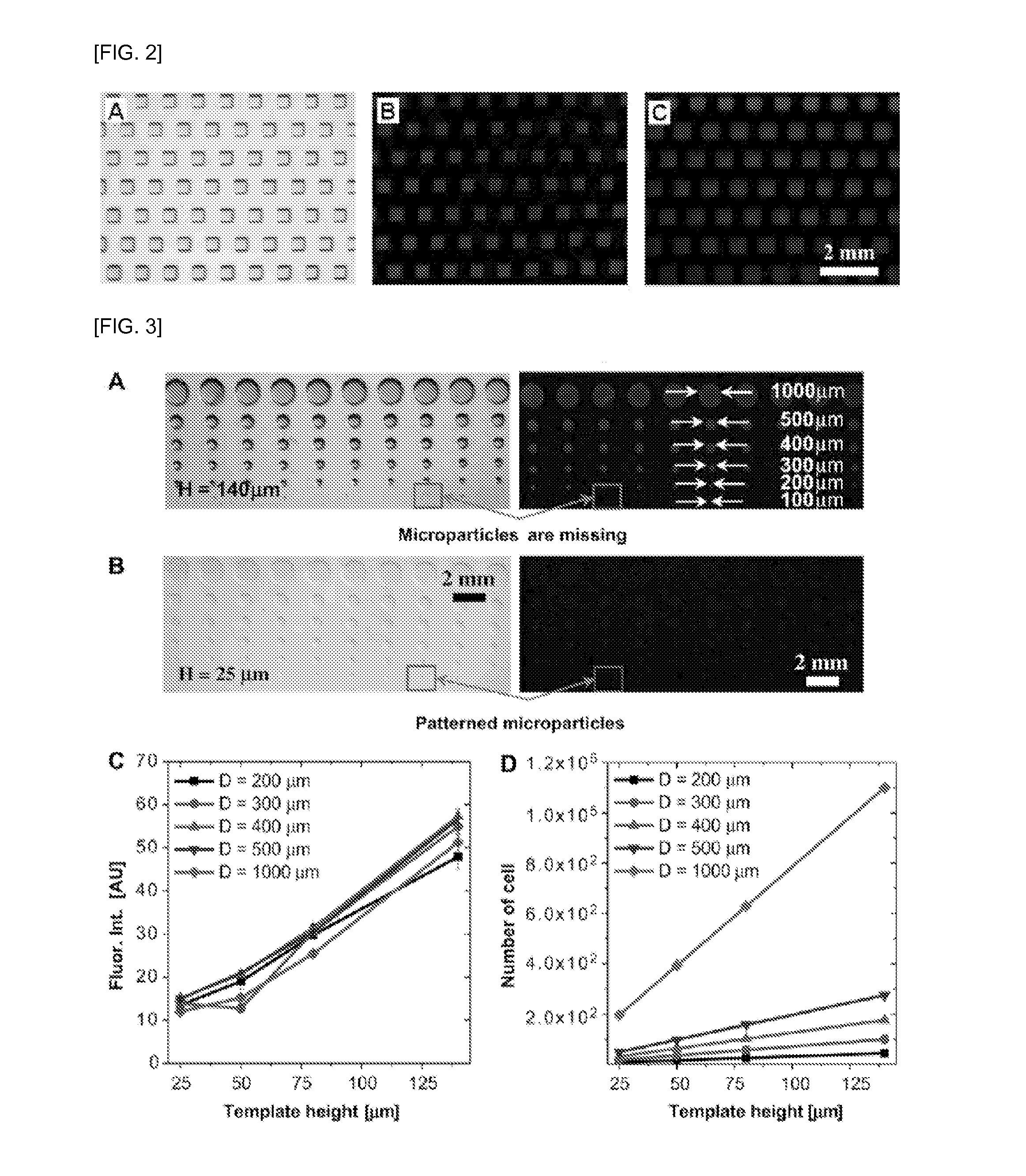Hydrogel patterning and transferring method of cells, and cell-based biosensor using same
a cell-based biosensor and encapsulation technology, applied in the field of cell-based biosensors, can solve the problems that the studies on transferring patterned cells to other substrates are not yet sufficient, and achieve the effects of high efficiency of high throughput screening, reduced costs and labor force, and high accuracy
- Summary
- Abstract
- Description
- Claims
- Application Information
AI Technical Summary
Benefits of technology
Problems solved by technology
Method used
Image
Examples
example 1
Escherichia coli Strains, Plasmids, and Culture Conditions
[0041]As shown in Table 1, this experiment was performed using two types of Escherichia coli strains MG1655 and DH10B. Competent cells of the MG1655 and DH10B were transformed with synthetically engineered genetic circuits. Some plasmids were transferred from the Registry of Standard Biological Parts, and the others were constructed in the experiment with different antibiotic resistance marker genes. For the growth of these strains, each Escherichia coli culture was grown overnight on M 9 agar solid medium plates with appropriate antibiotics at 35° C. A single colony was used to inoculate 5 mL M9 media with 1% glucose, 1% tryptone, and either 100 μg / mL ampicillin or 30 μg / mL chloramphenicol. Thereafter, the cultures were then grown overnight (16 hours) with vigorous aeration (200 rpm in a rotary shaker), and OD600=1.5-2 cells (1-2 mL) were centrifuged at 5000 rpm for 5 min. The obtained pellet was resuspended with fresh M9 me...
example 2
Fabricating Hydrogel-Encapsulated Cell Patterns
[0042]As shown in FIG. 1, the soft-lithography technology was used to fabricate an SU-8 (MicroChem Corp, 2150, 2050, and 2025, Newton, Mass., USA) mold on a silicon wafer with different thicknesses (25 μm, 50 μm, 80 μm, and 140 μm), and then about 1-mm thick PDMS replica of the mold was produced as reported in a literature. The PDMS surfaces were treated with oxygen plasma (Cute-MP, FemtoScience, Korea) under 70W and 50 sccm of oxygen for 50 seconds to change the hydrophobic surface to the hydrophilic to better fill the patterned microwells with a hydrogel solution.
[0043]The hydrogel solution was prepared by mixing sodium alginate (1% w / v, SigmaeAldrich) and necessary nutrients (1% glucose and 1% tryptone or 4% glycerol and 1% tryptone) in M9 media. After the alginate hydrogel solution was additionally mixed with living bacterial cells, the mixture was poured onto the PDMS replica / template surface to fill the patterned microwells of whi...
example 3
Transferring Hydrogel-Encapsulated Cell Patterns onto the Other Hydrogel Substrate
[0044]A PDMS frame was made on a glass slide to produce a hydrogel substrate on which the hydrogel-encapsulated cell patterns were transferred as shown in FIG. 1. A 1-mm thick PDMS slab was put on a glass slide, and the center area was cut and made empty to prepare a PDMS frame with a size of 2 cm×2 cm. An agarose hydrogel solution was prepared by mixing agarose (1% w / v), glucose (1% w / v), and tryptone (1% w / v) into M9 media and then additionally mixed with inducers or cells at 40° C. However, when arabinose was used as an inducer, glucose was substituted with glycerol (4% w / v) to avoid catabolic repression. Subsequently, the mixture was immediately cast into the PDMS frame and left at room temperature (24° C.) for gelation. After the frame was removed from the glass slide, the prepared PDMS template with hydrogel-encapsulated cell patterns was laid on the agarose hydrogel substrate. In 3-5 minutes, th...
PUM
| Property | Measurement | Unit |
|---|---|---|
| Length | aaaaa | aaaaa |
| Length | aaaaa | aaaaa |
| Photosensitivity | aaaaa | aaaaa |
Abstract
Description
Claims
Application Information
 Login to View More
Login to View More - R&D
- Intellectual Property
- Life Sciences
- Materials
- Tech Scout
- Unparalleled Data Quality
- Higher Quality Content
- 60% Fewer Hallucinations
Browse by: Latest US Patents, China's latest patents, Technical Efficacy Thesaurus, Application Domain, Technology Topic, Popular Technical Reports.
© 2025 PatSnap. All rights reserved.Legal|Privacy policy|Modern Slavery Act Transparency Statement|Sitemap|About US| Contact US: help@patsnap.com



